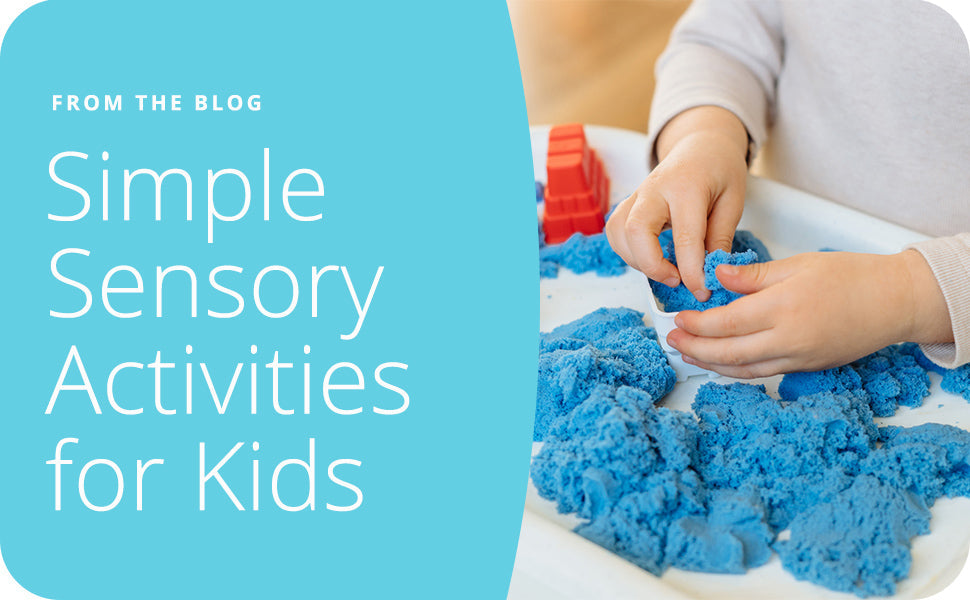[At Lucky & Me, we are not experts when it comes to sensory issues. But we do know a thing or two about being parents. Below is what has worked for us, and we wanted to share.]
Imagine this: you and your child have just entered the busy grocery store. Your child initially marveled at the bright colors and towering shelves filled with snacks and fruits. But as you both move deeper into the store, the noise from carts, people chatting, and beeping scanners becomes too much, and they start to cover their ears. The mix of smells—fresh bread, cleaning products, and cheeses—makes their noses scrunch up. Feeling overwhelmed, they grab onto your hand, pull, and start to get loud. They start yelling, “I want this snack, this cereal, I’m tired, hungry, etc.”
Your child has become overstimulated, and now, you feel like everyone in that grocery store is judging you. “How can a simple grocery store affect a child so much?” You ask yourself. Unsure of what to do next. You grab your child by the hand and storm out. As parents, we’ve been there. Every parent has probably been there. But, we found that with just a little bit of information and some sensory tips, parents can understand their children’s sensory needs a little better.
What are the senses?
The 5 main senses are sight, hearing, taste, smell, and touch. However, there are two other senses many people do not know about. These senses are external body awareness and internal body awareness. External body awareness is where children are aware of the external stimuli around them, while internal body awareness is where they are aware of their internal feelings/reactions/etc.
What is sensory processing?
As children grow, they start to notice and take in information from their senses. They process it and then have to respond in the appropriate way. This is called sensory processing. It is as simple as a child hearing the alarm for school and processing that it’s time to get out of bed or deciding if they want to get in the pool based on the temperature of the water. Often, children complete these everyday tasks without any trouble.
But for other children, all of this processing can become sort of hard to handle, or the information is perceived slower than it is supposed to. We, as parents, often do not even realize all of the sensory decisions a child has to make each day because we are so used to the sensory elements around us. This is why we parents are sometimes confused when our children struggle with the sensory world. We often find ourselves asking, “Why is my child reacting this way?”

There are two different types of sensory processing issues. One is over-responsive, where children are sensory sensitive and avoid sensory. They register all the senses and may be distracted by light or sound. They may also avoid touching things, loud noises, or activities where a lot is happening, like a busy playground. The other is under-responsive. This child is always on the go and is constantly looking for stimuli. They may chew on pencils, jump around, and have trouble sitting still. Or they may tire easier, react to stimuli slower, or appear to be clumsy.
There are things you can do to help your child if they are over-response or under-responsive, and this is where the tips and tricks come into play. Parents, if you do not feel like your child is over- or under-responsive, that doesn’t mean they won’t benefit from some of these things. All children can be over-stimulated or under-stimulated throughout their young lives, and adding these into your household can only help!
Signs of sensory issues
Children often show signs of sensory issues from an early age. They may not like the tag on their underwear or the scratchy elastic waistband. Although, some will grow out of these sensory problems. Some may need help from an occupational therapist or be diagnosed with a sensory processing disorder. Some common sensory issues children have are:
- Issues with clothing/underwear
- Appearing clumsy
- Behavior problems
- Covering eyes/ears frequently
- Difficulty adapting to changes
- Picky food preferences
- Difficulty with emotions
All of our children probably have had one or more of these signs while growing up, which is totally normal. But, if you feel as though your child has many of the signs above or is just struggling with the sensory world. You should talk to a medical professional.
Sensory-friendly activities
Whether your child has been diagnosed with a sensory processing disorder or not, it’s important to have a combination of movement and calming activities throughout the day. This way, children are able to be stimulated as well as calm or refocus when needed.
Movement activities can be as simple as running, jumping, skipping, or even using a trampoline (hello, trampoline park!). Calming activities are things like pushing hands together for 10 seconds, bear crawling, stacking legos, or rolling on an exercise ball on the stomach.
Many children can also benefit from sensory play. A simple sensory activity can allow a child to explore many different sensory elements. They can blow bubbles, play in a sand bin, bake, or try some new arts and crafts.

Helpful sensory objects
Sensory objects aim to engage a child's five senses—sight, sound, touch, smell, and taste. They incorporate features like vivid colors, various sounds, and different textures to achieve this goal. By offering a safe and enjoyable play environment, these toys support children in enhancing their sensory awareness and development.
Some favorite sensory objects of parents are:
Slime, kinetic sand, or putty:
Children can manipulate the substance independently or use other objects like a roller or cookie cutters, allowing for creativity and exploration. Plus, these slime, sand, or putty often come in vibrant colors, enhancing visual stimulation for young learners.
Sensory Mats:
A set of sensory mats, each featuring distinct textures. These compact mats allow children to explore various tactile sensations using their hands or feet.
Rainmaker:
Providing kids with a soothing experience as they listen to the calming sounds of "rain." The vibrant colors and cascading beads add another layer of engagement.
Body Sox or Weighted Blanket:
Both objects allow children to feel safe, and the pressure from these objects helps with anxiety and relaxation.

Chew Necklaces/objects:
Sensory chew toys are handheld items crafted from safe materials like non-toxic silicone or fabric. Designed to offer sensory stimulation for children, these toys come in many textures.
Books:
As a child, it may can overwhelming trying to navigate their senses, reading them books that are relatable to what they may be currently experiencing can help them better understand themselves and the world around them. And as an added bonus, can spark some meaningful conversations.
There you have it: children experience the world in many different ways, and it can be a challenge for children with sensitivity to the senses and even children without. Becoming overstimulated or under stimulated can cause many problems, but having the right tools can help!


